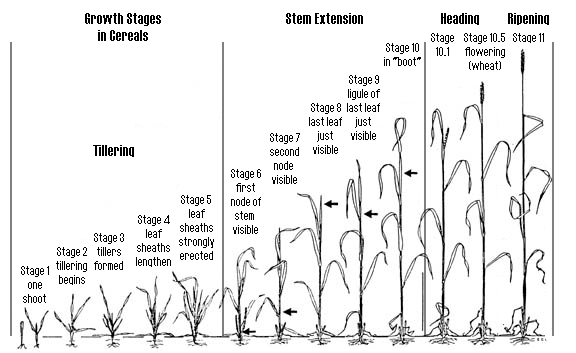10 Apr 2008
URL: http://www.kingcorn.org/news/articles.08/Wheat-LateN-0410.html
Late Nitrogen Applications on Wheat
Jim Camberato and Chuck Mansfield
Agronomy Dept., Purdue Univ.
West Lafayette, IN 47907-2054
Email addresses: jcambera@purdue.edu
and cmansfie@purdue.edu
- Wheat growth stage determines potential response to applied nitrogen
- Reduced rates recommended for wheat that is jointed and growing rapidly
- Wheat pre-jointing will benefit from full rate nitrogen application
It is not too late to topdress wheat with nitrogen fertilizer. Although it is best to have nitrogen (N) applied prior to jointing, wheat can respond to N applied through emergence of the flag leaf. However, as the season progresses, more physical damage is done to wheat by N application with ground equipment. Also, less yield response is obtained and more increase in grain protein is observed with later applications of N.
Topdress N rate should be adjusted down 10-15 % for wheat that is already jointed (Feekes Growth Stage (GS) 6 – see figure below). For more descriptions of wheat growth stages, see the references cited below. As wheat continues to progress through Feekes GS 7 to GS 9, the response to applied N is likewise reduced and further reductions in N rates should be made. No benefit to applied N fertilizer will be realized after the flag leaf is fully emerged (Feekes GS 9). Wheat across the southern third of Indiana is jointed and some wheat is already in Feekes GS 7. For the rest of the state, wheat is either beginning to joint or (for northern Indiana) is still at Feekes GS 4 to GS 5 where one would expect it to benefit from the full rate of N.
There are pluses and minuses to all fertilizer sources especially as the season progresses. Liquid fertilizers are going to burn more than solids. When applying liquid N, use streamer bars or drop nozzles, not flat fans, to minimize contact with the leaf tissue. You can also reduce the burn potential by diluting the liquid N half and half with water. Of the solid N sources, urea will burn less than ammonium nitrate or ammonium sulfate.
Surface-applied liquid urea-ammonium nitrate (UAN) and urea always have the potential to lose N to the air by ammonia volatilization, but the potential is higher now with warm temperatures than earlier in the year when it was cold. Under worst case conditions, 15 to 30% of the N may be lost from UAN and urea. Adding a urease inhibitor to UAN and urea may be warranted to reduce ammonia loss. Little N will be lost from surface-applied ammonium nitrate or ammonium sulfate, but they are more expensive and can cause more foliar burn than urea-containing fertilizers. Adding a nitrification inhibitor to the N fertilizer is unlikely to be beneficial with late application of N. Use of slow-release N fertilizers may result in inadequate N availability and are not recommended for use at this time.
FEEKES GROWTH STAGES IN WINTER WHEAT

Image source: http://nue.okstate.edu/GSchart.htm
Related References
NUEweb. Physiological Feekes Growth Stages in Winter Wheat. Date unknown. Oklahoma State Univ. [On-line]. Available at http://nue.okstate.edu/GSchart.htm. [URL accessed 4/10/08].
Shaner, Greg, Charles Mansfield, and Bill Johnson. 2008. Identifying Wheat Growth Stages. Pest & Crop Newsletter, Purdue Extension, Purdue Univ. [On-line]. Available at http://extension.entm.purdue.edu/pestcrop/2008/issue2/index.html#identify. [URL accessed 4/10/08].

